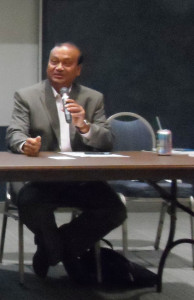College Students Showcase Technology’s Future

It was a rainy Saturday in June, and Perry Carter, president of BDPA Washington, D.C. had invited me to serve on a panel to talk to students about technology and cybersecurity careers and life in general. The panel was part of BDPA’s 2015 Annual Regional IT Showcase where high school and college students showcase their technology innovations. Two Bowie State University undergraduate students who conduct research under the mentorship of Dr. Jesse Bemley wowed the audience with their innovative and practical use of technology to solve current societal problems.
The first presentation was by Ogochukwu Eburuoh who showed how mobile health technology could improve population health. She demonstrated how this technology could make healthcare highly accessible in even remote African villages where doctors or expensive instruments such as EKG machines were not readily available. Eburuoh's experiments actually proved that mobile health devices gave better results than EKG tests. Mobile phone penetration in developing countries is actually quite high, therefore mobile health apps and technology is a practical and viable option, she said. Village patients accept mobile health tools because patients feel a sense of prestige in possessing the technology and took great pride in using it, Eburuoh said. Thus they took better care of their health and took the right doses of their medicine, she added. In addition, providers can use apps to monitor patients' in a highly cost-effective manner, said Eburuoh.
Rising senior Joseph Udensi Emelike, who is majoring in computer science at Bowie State University and expects to graduate in 2016, is focusing on high performance computing because of its applications in the scientific community and its role in data science. He also participates in the HPC program at UMBC. Emelike started his presentation with an excellent explanation of the problems with single processor computers and operating systems of today. First, a single processor performs tasks serially, he said. Therefore, large complex processing can take extraordinarily long. In addition, computers with faster single processor CPUs quickly run into a power wall and associated overheating problem rather quickly, Emelike said.
The solution, Emelike explained, is parallel processing where multiple processors (or computers) perform tasks simultaneously. This is how supercomputer configurations work. However, such supercomputers have tended to be expensive and inaccessible to everyone. So Emelike built a 6-node supercomputer using six commercial, off-the-shelf blade computers inside a single computer case, named LittleFe. To operate LittleFe, Emelike used a Linux-based Bootable Cluster CD (BCCD) operating system developed at Earlham College.
Emelike developed several applications for LittleFe. He and fellow student Bryan Bemley demonstrated how rapidly LittleFe performed various tasks. I was so impressed that I went up to talk to Emelike and asked him if he was planning to use the new generation of cheaper Raspberry Pi 2 computers in his future experiments instead of the more expensive blade computers. That could bring the costs down even further and increase accessibility of students to high performance computing even higher. With a smile, Emelike and Bemley agreed they did have such plans. In addition, Emelike intends to continue working with LittleFe and develop an application for the system that will further demonstrate the educational utility of LittleFe. After completing his undergraduate degree, he plans to pursue a graduate degree in applied mathematics or computer engineering. I cannot wait to see what these bright young computer scientists will produce next.
About the Author
Dr. Mansur Hasib is the only cybersecurity and health information technology professional in the world with 12 years experience as Chief Information Officer, a Doctor of Science in Cybersecurity, and the prestigious CISSP, PMP, and CPHIMS certifications. A global thought leader, Dr. Hasib has led technology and cybersecurity strategy for almost 30 years in healthcare, education, biotechnology, and energy. He is a frequent speaker at local, national, and international conferences. For his doctoral dissertation in 2013, Dr. Hasib conducted a national study in US healthcare and examined the relationship between cybersecurity culture and cybersecurity compliance. He shares these results in a book titled Impact of Security Culture on Security Compliance in Healthcare in the USA. In September 2014, Dr. Hasib published the new edition of Cybersecurity Leadership: Powering the Modern Organization. In this work he shares his cybersecurity leadership and governance model and life-long learning with many examples drawn from his practical experiences, research, and observations. His leadership model is applicable in any organization. Dr. Hasib served as Chief Information Officer at the Baltimore City Health Department and within the University System of Maryland for 12 years. He currently teaches and mentors the next generation of organizational executives at several US universities. Contact Dr. Hasib via his website: www.cybersecurityleadership.com
Related
Managing editor of Enterprise Technology. I've been covering tech and business for many years, for publications such as InformationWeek, Baseline Magazine, and Florida Today. A native Brit and longtime Yankees fan, I live with my husband, daughter, and two cats on the Space Coast in Florida.











